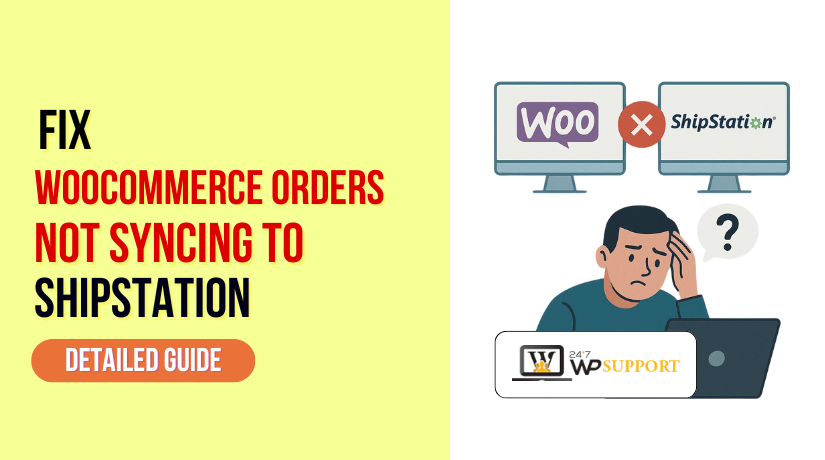
WooCommerce Orders Not Syncing to ShipStation? Here’s the Fix
Introduction
If you run a WooCommerce store, ShipStation is likely your go-to tool for shipping. It helps automate order fulfillment and save time. But what happens when WooCommerce orders stop syncing to ShipStation?
This issue can be frustrating and hurt your workflow. Orders may not appear in ShipStation at all. Or worse, they may appear with missing or incorrect details. This causes delays in shipping and unhappy customers.
Many users report similar problems, such as:
- Orders not importing from WooCommerce
- Order statuses not updating in ShipStation
- The plugin not reconnecting after disconnection
In this guide, we’ll walk you through the top reasons why this happens. You’ll learn how the integration works, and how to fix the issue quickly.
We’ll also show you how to prevent it from happening again. Whether you’re a beginner or a store manager, this guide is for you.
How WooCommerce Connects to ShipStation
The WooCommerce and ShipStation integration is simple but powerful. It uses a plugin and an API to sync data between your store and ShipStation.
Once connected, ShipStation pulls new orders from WooCommerce using the API. These orders then show up in your ShipStation dashboard for fulfillment.
But for this to work, several things need to be in place:
- A working API connection
- Proper plugin configuration
- Correct cron job scheduling
Let’s break those down.
API Connection
ShipStation uses API keys to access WooCommerce. These keys allow the two platforms to communicate. If the API connection is broken, syncing will fail.
Common issues with the API include:
- Expired or deleted API keys
- Incorrect store URL entered in ShipStation
- Server blocking API requests
You’ll need to re-check your credentials if orders aren’t showing.
WooCommerce ShipStation Plugin
The plugin is the bridge between WooCommerce and ShipStation. If the plugin is outdated or corrupted, syncing issues occur.
Watch out for these warning signs:
- The plugin dashboard not loading
- Orders stuck in “processing” without shipping data
- “WooCommerce ShipStation Plugin 500 Error” showing up
Update the plugin to the latest version and test again.
Cron Jobs
WooCommerce uses cron jobs to handle background tasks. This includes syncing with ShipStation at set intervals.
If cron jobs fail, orders won’t sync automatically. You might have to trigger a manual sync.
You can use a plugin like WP Crontrol to monitor this. If you see missing or delayed tasks, fix them right away.
Common Signs of Sync Failures Between WooCommerce and ShipStation
Sync issues between WooCommerce and ShipStation are not always obvious. Sometimes, it’s clear. Other times, the problem is hidden until a customer complains.
Here are the most common signs of a sync failure:
- Orders Not Appearing in ShipStation
You check your ShipStation dashboard and see missing orders. These orders exist in WooCommerce but were never imported. This is a clear sign of sync failure.
Possible causes:
- API connection is broken.
- Plugin is outdated or has a bug.
- Cron job responsible for syncing has failed.
Missing orders delay shipping and create customer service issues.
- Order Status Not Updating Correctly
Orders marked as “Shipped” in ShipStation don’t reflect the change in WooCommerce. This leads to confusion for both store owners and customers.
You might notice:
- Orders stuck in “Processing” even after shipment.
- Customers not receiving tracking information.
- Dashboard data not updating correctly.
This is often due to ShipStation not updating order status in WooCommerce.
- Partial or Incomplete Order Details
Some orders do appear in ShipStation but with missing fields. It may be missing a product line, customer info, or shipping address.
This happens when:
- Data sync is interrupted mid-process.
- The WooCommerce order includes unsupported characters.
- There’s a mismatch in timezone or formatting.
Errors like these lead to mispackaged orders or failed deliveries.
Initial Fixes to Restore WooCommerce and ShipStation Syncing
Fix 1: Check and Reauthorize Your API Connection
The ShipStation WooCommerce API authorization error is a common cause of sync problems. ShipStation relies on API credentials to talk to your WooCommerce store.
If those credentials expire, the sync stops.
Steps to Fix:
- Login to your ShipStation dashboard
Go to Account Settings > Selling Channels > Store Setup. - Click your WooCommerce store connection
Review the API keys and endpoint listed. - Verify credentials in WooCommerce
Check under WooCommerce > Settings > Advanced > REST API. - Create a new API key if needed
Sometimes keys stop working without notice. Regenerate a fresh one. - Re-enter the new API info in ShipStation
Paste the new keys back into your ShipStation settings. - Save and test the connection
Use the “Test Connection” button to confirm syncing is active.
This step alone can fix most cases where ShipStation orders are not importing from WooCommerce.
Fix 2: Resolve the WooCommerce ShipStation Plugin 500 Error
The “500 Error” is a server-side error. It typically means the plugin crashed while trying to perform a task.
You might see:
- Blank screen when opening plugin settings.
- ShipStation unable to pull data from WooCommerce.
- An error log in your dashboard showing code 500.
How to Fix the 500 Error:
- Update the plugin
Outdated versions may not support the latest WooCommerce or WordPress. Always use the latest stable release. - Check for plugin conflicts
Deactivate all other plugins temporarily. Then test if the ShipStation plugin works alone. If it does, re-enable plugins one at a time to find the conflict. - Check PHP and server limits
A low memory limit or old PHP version may crash the plugin. Ask your hosting provider to raise the memory limit to at least 256MB and update PHP to 7.4 or later. - Review server logs
Use your hosting control panel or FTP to check the error logs. Look for recent entries that mention the ShipStation plugin. - Reinstall the plugin if needed
Remove the plugin and install it fresh. This won’t delete your data, but always back up first.
Once fixed, your orders should start syncing again without the “WooCommerce ShipStation Plugin 500 Error.”
Advanced Fixes for WooCommerce and ShipStation Syncing Problems
Some syncing issues need deeper troubleshooting. If basic fixes didn’t work, try these advanced steps. These will help you fix errors caused by system mismatches, plugin conflicts, or broken integrations.
Let’s explore each one in detail.
- Reconnect Your WooCommerce Store to ShipStation
If your connection keeps failing, a full reconnection can help. This resets the link between your store and ShipStation.
When to use this fix:
- You see frequent sync timeouts
- Orders stop importing completely
- The plugin won’t reconnect after updates
Steps to reconnect:
- Go to ShipStation > Account Settings > Store Setup
- Click on your WooCommerce store
- Remove the current store connection
- In WooCommerce, create a new API key
- Add the new key and store URL to ShipStation
- Click “Test Connection” to confirm the link is active
After reconnecting, place a test order to see if syncing works.
This helps resolve issues like WooCommerce ShipStation Plugin Not Reconnecting and Reconnect WooCommerce Store to ShipStation problems.
- Fix Plugin Compatibility Conflicts
Sometimes, ShipStation stops working because of conflicts with other plugins. This happens often after WooCommerce or WordPress updates.
Signs of a conflict include:
- Admin panel crashes when accessing the plugin
- Orders syncing with missing data
- Site slows down during syncing
How to find and fix conflicts:
- Disable all plugins except WooCommerce and ShipStation
- Test the sync function with only these two active
- Re-enable plugins one by one, checking the sync each time
- When syncing fails again, the last plugin enabled is likely the cause
- Consider replacing or updating that plugin
Also, check your theme. Some custom themes block or filter API calls.
Fixing these issues can resolve WooCommerce ShipStation Plugin Compatibility Issues.
- Resolve Timezone Mismatches Between Platforms
Timezone mismatches can delay syncing or cause missed orders. ShipStation and WooCommerce may use different time settings by default.
This leads to:
- Orders syncing at the wrong time
- Delays in exporting recent orders
- Orders not appearing until hours later
Steps to fix timezone mismatch:
- In WordPress, go to Settings > General
- Set your site’s timezone to match your actual store location
- In ShipStation, go to Account Settings > Display Options
- Set the same timezone as in WordPress
- Save the changes and run a sync again
Fixing this resolves WooCommerce ShipStation Timezone Mismatch and ensures smoother syncing.
- Check for Cron Job Failures
If your cron jobs aren’t working, syncing will fail in the background. This affects auto-importing of new orders into ShipStation.
Even if everything else looks fine, a failed cron will stop syncing.
How to troubleshoot cron jobs:
- Install the WP Crontrol plugin
- Check for scheduled events like wc_shipstation_export
- If they’re missing or overdue, clear and re-add them
- Run a manual sync to confirm it works
- Ask your host to enable real cron (not WP-Cron) if needed
This solves WooCommerce Cron Job Sync Failure with ShipStation.
Bonus Tip: Enable Debug Mode
Many ShipStation errors are hidden. Enabling debug logs helps you trace problems.
How to turn on debugging:
- Go to WooCommerce > Settings > Integration > ShipStation
- Enable the debugging option
- Review logs under WooCommerce > Status > Logs
Look for failed API calls, plugin errors, or connection issues.
Best Practices to Avoid Sync Problems
A few smart habits can prevent most syncing failures. These steps reduce plugin errors, connection losses, and compatibility issues.
Here’s what you should do regularly:
- Update plugins and WordPress core
Always use the latest version of WooCommerce and the ShipStation plugin. Updates include bug fixes that improve syncing. - Back up your site before making changes
Use a reliable backup plugin before updating WooCommerce, themes, or plugins. This helps you roll back quickly if syncing breaks. - Use a staging site for testing
Test changes on a staging copy of your site. This avoids live store issues. - Monitor API and error logs
Check WooCommerce logs under WooCommerce → Status → Logs. Look for API failures or plugin errors. - Don’t overload your site with plugins
Too many plugins increase the risk of conflicts. Keep only what you need.
These simple steps reduce the risk of ShipStation connection lost with WooCommerce or plugin compatibility failures.
When to Contact Support or a Developer
Sometimes, fixes don’t work even after trying everything. If the problem continues, you may need expert help.
Here are signs it’s time to reach out:
- Orders still not syncing after basic and advanced fixes
- Frequent API timeout or 500 errors
- No response from ShipStation after test orders
- You find errors in log files you don’t understand
You can contact both ShipStation Support and WooCommerce Support. If you’re using a managed host, they may also help.
But if you need faster help or full troubleshooting, expert WordPress help is best.
Get Professional Help from 24x7WP Support
At 24x7WP Support, we handle WooCommerce issues daily. Our team knows how to fix ShipStation sync problems fast.
We help with:
- Plugin setup and debugging
- Full API connection fixes
- Cron job repair and server checks
- Long-term sync monitoring and optimization
Don’t let shipping delays hurt your business. Reach out today and let our experts handle it.
Conclusion
Sync issues can be stressful. But with the right steps, they are fixable. From plugin updates to deep troubleshooting, this guide has covered it all.
Take action early, monitor your setup, and get help when needed.
Your orders should now sync smoothly with ShipStation — just the way they should.



